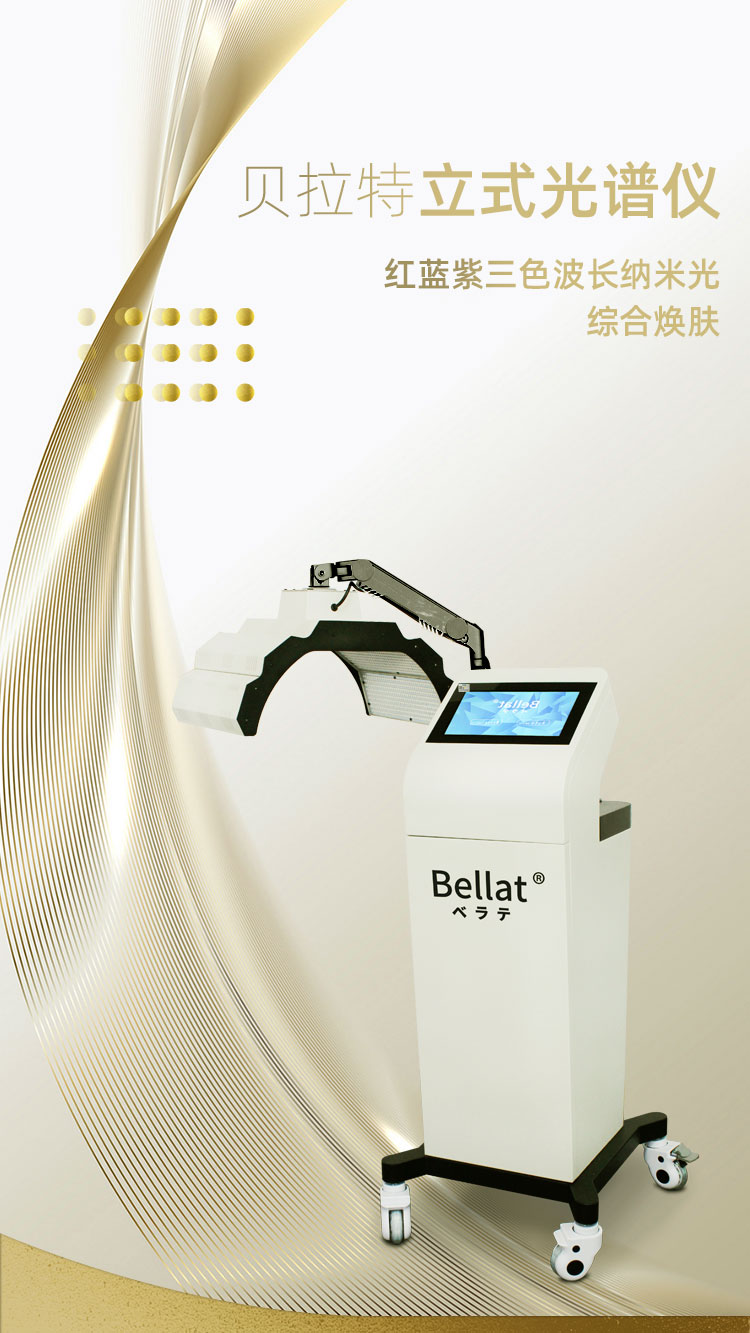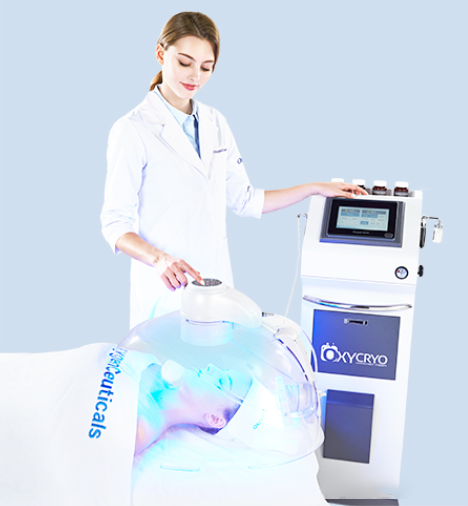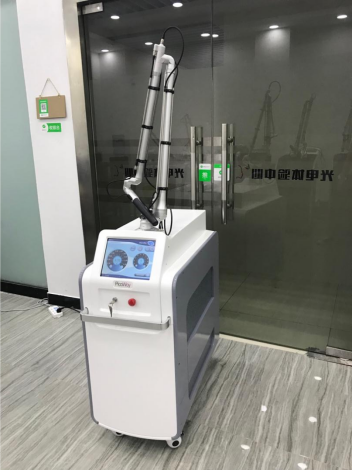1. Principle
808nm refers to the wavelength of the laser being 808 nanometers long. It is the best wavelength for laser hair removal. It absorbs less hemoglobin and water. Laser of a specific wavelength can only be selectively absorbed by the target color base. In laser hair removal, the hair follicle and hair shaft The melanin in the hair follicle is a target color base. It absorbs light energy and generates high temperature. When the temperature reaches about 45°C, it is kept warm, causing the hair follicles to generate heat. The penetration depth can reach the target tissue (dermal papilla) without relying solely on the hair shaft. conduction, so it has a good effect on fine and light-colored hair, and uses a sapphire contact cooling treatment head to cool the epidermal temperature to -5℃~5℃, which can effectively reduce the epidermal temperature before, during and after laser irradiation. , synchronizes treatment and cooling, protects normal skin tissue from damage, makes you feel more comfortable, does not damage surrounding tissue, only destroys the key role of the dermal papilla, prevents hair growth, and achieves the effect of permanent hair removal, but does not damage the sweat glands.
808nm laser hair removal can be applied to various parts of the body, such as armpits, arms, legs, hairline, upper lip, face, bikini line, etc.
Hair growth has anagen (anagen), regression (catagen) and resting (telogen) phases. During the growth phase, the hair matrix cells divide rapidly, with the most melanin during this phase, so they are extremely sensitive to laser; during the catagen phase, the hair matrix degenerates and the dermal papilla atrophies; during the resting phase, the hair follicles separate from the dermal papilla, and the hair falls off. The resting phase time varies depending on the location.
1. Because laser has no obvious effect on hair in the catagen and resting phases, the laser can only work after these hairs enter the growth phase. Therefore, laser hair removal requires multiple treatments before the effect is obvious.
2. If the proportion of hair in a certain area is in the growth phase, the number of treatments should be increased. On the contrary, the number of treatments can be reduced.
3. Because hair in different parts of the body has different growth cycles, the intervals between treatments are also different. If the hair on the head has a relatively short resting period, the interval can be as short as one month; the hair on the trunk and limbs has a relatively long resting period, so the treatment interval is about two months.
4. If the density of hair follicles in a certain area is too high, the laser energy should be appropriately reduced during treatment.
2. Installation
1. It is best to keep the box for one year to avoid needing it for future maintenance.
2. Probe installation
3. The instrument must be powered on by adding water, otherwise the probe will be burned out. Add Watsons distilled water (the water must flow smoothly, otherwise the treatment tip will be burned out if the water is not filled).
4. Change the water every one month. To change the water, open the water outlet and let the old water flow out. Then cover the water outlet and refill the water, as in step 3.
3. Preoperative examination work
1. Ask guests if they have photosensitivity (solar rash, lupus erythematosus). A small number of people will become red, swollen and itchy when exposed to the sun. This phenomenon cannot be used with optical instruments;
2. Those who have had optical instrumentation done on the same part within one month will have it done one month later;
3. Do not wear jewelry, watches and other accessories during treatment;
4. Pregnant women, lactating mothers, patients with heart disease, serious illnesses, or those with open wounds are prohibited from doing this;
5. People who have had plastic surgery can receive treatment as long as they recover.
6. Skin malignant tumors or precancerous lesions
7. People who have recently tanned or sunburned or plan to take a vacation in the sun
8. Acute skin infection (herpes, chilblains) or various skin lesions
9. Those who have taken photosensitivity drugs recently (within one month)
10. Thin (referring to skin resurfacing) dry skin
11. Patients with pacemakers.
12. Patients with metal in their bodies (including dental braces) and facial prostheses should be bypassed without surgery.
13. Skin in the allergic stage
14. If you have a tattoo, you cannot do it on any part of the body.
15. Avoid areas with moles
4. Project process
Operating time: 20 minutes
1. Any part of the operation must be shaved. It does not need to be shaved very clean. Leaving a little burr will give better hair removal effect; or ask the customer to shave the hair completely at home two or three days in advance. A little burr will grow in two days. Come and take off your clothes; (3 minutes)
2. Clean the operating area with pure water or use a physiological wipe (1 minute)
3. Apply gel. Apply a thin layer of gel as thick as a coin to dissipate heat and lubricate. Refrigerate the gel before applying it to improve comfort; 1 minute)
4. Adjust parameters, starting from low energy (for example, starting from about 5)
5. Test, try two rounds when the operation is unstable to see if the parameters are appropriate; the hair removal energy should be adjusted until the customer feels a slight tingling or slight tingling sensation for the best effect; (2 minutes)
6. Adjust the energy until the client’s hair removal area feels slightly tingling.
7. Start the formal operation. The probe should be close to the skin, and each part should be operated 8 or 10 times in an orderly manner.
Techniques for operating large parts (such as back, arms, thighs): You can use the sliding technique to put the probe close to the skin. Press the handle switch to light up and start pushing it in an even speed and sequence, and operate it more than 5 times. (Do not stay on the same skin after the light is applied, otherwise you will be easily burned) (10-15 minutes)
Techniques for operating small parts (such as hairline, lip hair, etc.): Use the stamping technique, put the probe close to the skin, press the handle switch to emit light, lift it up, and then apply it again, just like stamping. During operation, the first light spot should be close to the next light spot to ensure that every place is hit, and the operation should be performed about 8 times. (5-10 minutes)
8. Cleaning: After the operation, use the mask stick to hang up the gel tissue and wipe all the gel, then wipe it clean with saline to complete the operation; (1 minute)
Operation skills:
If you want the effect to be faster and better, you can apply it several times until the skin is a little red, and then use tweezers to pull out some burrs on the spot. If you can't remove it on the spot, you can ask the customer to go home in about 7-10 days and you can easily remove it. Just fall off. This method of operation will reduce the number of treatments, but it is only suitable for areas with thick hair, such as armpits, hairline, thicker leg hair, etc.
5. Parameters
1. Energy: Start adjusting from 3, usually around 6-8, adjust according to the customer's feelings (adjust to a slight tingling sensation, or a slight tingling sensation)
2. Frequency: 2
3. Treatment course: once a month, or once a month and a half
Coarse hair: 3-4 times
Fine hair: 5-8 times
6. Postoperative care
1. If there is a strong feeling of heat, it is recommended to apply ice to the customer;
2. Instruct customers to wear sunscreen within 30 days after taking off their clothes, apply sunscreen when going out, hold an umbrella, etc.;
3. The hair removal area should not be exposed to hot water for 6 hours;
4. No saunas, hot springs, or swimming within 7 days;
5. It is recommended to put on makeup after 1 day;
6. If there is a little bit of redness or inflammation after the procedure (this rarely happens), it may be that the probe is not clean and infected or the skin is not clean, or the customer has folliculitis, photoallergy, etc. You should apply ice or apply some Erythromycin ointment. Do not bask in the sun or in places with high temperatures, and keep it ventilated.





